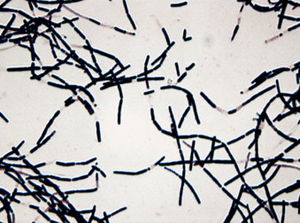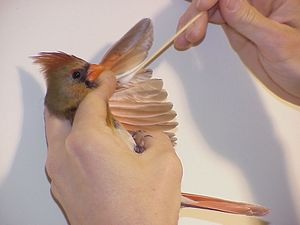Bacillus licheniformis
A Microbial Biorealm page on the genus Bacillus licheniformis
Classification
Higher order taxa
cellular organisms; Bacteria; Firmicutes; Bacilli; Bacillales; Bacillaceae; Bacillus; Bacillus licheniformis
Species
|
NCBI: Taxonomy |
Bacillus licheniformis
Description and significance
Bacillus licheniformis is a bacterium that is commonly found in soil and bird feathers. Birds that tend to stay on the ground more than the air (i.e. sparrows)and on the water (i.e. ducks) are common carriers of this bacterium; it is mostly found around the bird's chest area and back plumage.
Bacillus licheniformis is part of the subtilis group along with Bacillus subtilis and Bacillus pumilus. These bacteria are commonly known to cause food poisoning and food spoilage. Bacillus licheniformis also is known for contaminating dairy products. Food borne outbreaks usually involve cases of cooked meats and vegetables, raw milk, and industrially produced baby food contaminated with Bacillus licheniformis.
This bacterium, although detrimental, can be modified to become useful. Researchers are trying to turn it into a nutritious livestock feed by fermenting it with the non-digestable proteins on bird feathers. There is also research about the possibility that Bacillus licheniformis causes changes in color in birds' feathers; this will provide information on the evolution of molting. Also, cultures of Bacillus licheniformis are made to retain its protease, which is in turn used in laundry detergent.
Genome structure
Describe the size and content of the genome. How many chromosomes? Circular or linear? Other interesting features? What is known about its sequence? Does it have any plasmids? Are they important to the organism's lifestyle?
Cell structure and metabolism
Describe any interesting features and/or cell structures; how it gains energy; what important molecules it produces.
Bacillus Licheniformis is a Gram positive, thermophillic bacterium. Its optimal growth temperature is 50°C, but it can also survive at much higher temperatures. Its optimal temperature for
Ecology
Describe any interactions with other organisms (included eukaryotes), contributions to the environment, effect on environment, etc.
Pathology
Bacillus licheniformis is commonly associated with food spoilage and poisoning. It causes bread spoilage, or more specifically, a condition called "ropy bread." Contamination will make the bread sticky and stringy; the ropy bread will also start to develop a strong odor after contamination. Rope spores is what causes the spoilage; unfortunately these spores do not get killed during the baking process.
It can also cause food-borne gastro-enteritis, which is infection of the gut which could lead to a life threatening condition called Septicaemia. Septicaemia is blood poisoning, it is classified as having a large amount of bacteria in the blood. Dairy products are at increased risk of being contaminated with toxin-producing isolates of Bacillus licheniformis. Cooked meats, vegetables, and processed baby foods are also at risk.
The symptoms include stomach pains, (acute) diarrhea, and possible vomiting. These have an onset time of 2-14 hours and last no longer than 36 hours.
Bacillus licheniformis, although usually associated with the gut and gastrointestinal tract, can also cause distress in other parts of the body. It can cause ophthalmitis, which is the inflammation of the eye. It can even go as far as causing abortions in pregnancies.
Application to Biotechnology
Does this organism produce any useful compounds or enzymes? What are they and how are they used?
Researchers are trying to recycle bird feathers by turning them into nutritious food for livestock.As mentioned, Bacillus licheniformis is commonly found on bird feathers; by fermatation with Bacillus licheniformis, the large amounts of non-digestible proteins found in the feathers can turn into a feather meal for livestock. This is desired because it is cheap and nutritious.
Current Research
Enter summaries of the most recent research here--at least three required
References
http://en.wikipedia.org/wiki/Bacillus_licheniformis
http://www.pubmedcentral.nih.gov/articlerender.fcgi?artid=91618
http://www.ncbi.nlm.nih.gov/entrez/query.fcgi?cmd=Retrieve&db=PubMed&list_uids=15461803
http://www.g2l.bio.uni-goettingen.de/projects/c_proj_bl.html
Edited by Thu Mai, student of Rachel Larsen and Kit Pogliano


